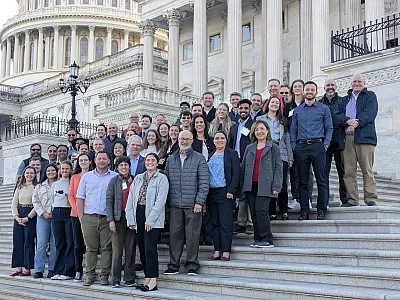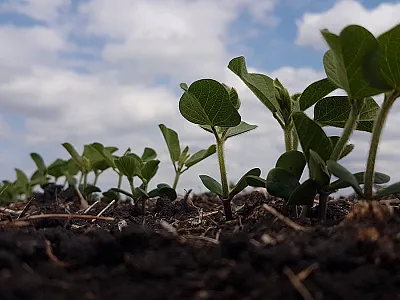A Simple Test for Determining the Late-Maturity Alpha-Amylase Susceptibility Window in Wheat


Late-maturity alpha-amylase or LMA is a weather-related event that lowers the quality of affected grain, resulting in sticky breads, cakes, and noodles with unattractive and undesirable textures. Grain that has been affected by LMA, or that is susceptible to LMA, cannot be identified by sight alone due to varietal- and environmental-induced differences in appearance and differences in rates of development. Techniques that allow for rapid identification of the LMA susceptibility window in wheat and knowledge of the weather events that lead to LMA can empower growers to manage and mitigate LMA-induced profit loss. Earn 0.5 CEUs in Crop Management by reading this article and taking the quiz.
Variable weather events wrought by climate changes have made it more difficult for growers to maintain the quality of their wheat crop. In the Pacific Northwest (PNW), these changes have increased the occurrence of the weather related events known as preharvest sprouting (PHS) and late- maturity alpha-amylase (LMA). Both PHS and LMA substantially lower grain quality through induction of alpha-amylase proteins. Alpha-amylase proteins degrade starch in the wheat endosperm, and if their levels are too high, can result in sticky breads, cakes, and noodles with unattractive and undesirable textures (Buchanan & Nicholas, 1980; Olaerts & Courtin, 2018). In a given year, growers may be impacted by PHS and LMA and depending on the severity of these events, may receive financial discounts administered at the discretion of elevators (Hauvermale & Thompson, 2024). While the grain industry is very familiar with PHS, both the phenotype and causes, less is understood about the relatively new phenomenon, LMA. For these reasons, it is critical to define what is known about LMA, and provide growers and agronomists with a field tool for easily identifying when grain is susceptible to LMA induction. This information will help to empower better post-harvest decision making and management when LMA events do occur.
Weather That Causes LMA
First identified in the PNW in 2012, LMA occurs during grain filling in immature seeds and has no visual phenotype, making contamination with sound grain very easy. Late-maturity alpha-amylase events have already led to significant financial losses for growers, most notably during 2016, and the frequency of LMA events have also increased, only exacerbating an already serious problem (Hauvermale & Thompson, 2024; Bettge, 2018). Although there are conflicting reports in the literature, the most consistently described and accepted LMA-inducing weather conditions include cold snaps and exposure to longer durations of cool wet temperatures during grain filling. The greater the temperature drop during the cold snap, the greater the LMA event, with a temperature drop of 9–12.6 °F in mean or maximum temperatures causing substantial LMA induction (Mrva & Mares, 2004). For the varieties responsive to constant cool, wet conditions, a temperature under 70°F during the daytime and under 50°F during the nighttime is sufficient to induce LMA (Mrva & Mares, 2004). It is also important to note that not all susceptible wheat varieties respond to either condition consistently, and in the PNW, it has not yet been determined how cool or wet conditions need to be, or for how long, to induce LMA across varieties (Wheat Life, 2024). What is certain, however, is that across varieties, LMA can only be induced during a small window of susceptibility at a specific stage of wheat development.

Zadoks Scale and the Susceptibility Window
Determining the LMA susceptible window for wheat is an essential tool for agronomists and growers to evaluate potential risk for exposure to LMA-causing weather events. This can be done using the Zadoks scale, which is used internationally as a consistent measure of wheat development for research, advisory work, and farm practice (Liu et al., 2021a; Mrva & Mares, 2001). The Zadoks scale covers discrete developmental stages from 0–99 (Figure 1). Immature wheat seeds are vulnerable to LMA during grain filling across Zadoks stages 83 to 85, also known as the soft dough stage (Peery et al., 2023). Tillers in this stage usually retain some green coloring in the stem and have spikes that are transitioning from green to gold or are gold in color (Figure 2). Visible indicators of wheat development during the soft dough stage, such as stem, head, or seed color, might not necessarily be consistent across different varieties or between individuals under different environmental conditions (Liu et al., 2021a). For example, wheat with the “Stay Green” gene retains a green color into the grain-filling phase while other wheat varieties do not (John et al., 2016). Additionally, the speed at which wheat reaches the susceptibility window and transitions in and out differs by variety. Therefore, physical inspection of the seed and a test of developmental stage are necessary to accurately determine if the plant is susceptible to LMA.

Growers and agronomists can use the fingernail or tweezer test to determine whether or not a plant is currently susceptible to LMA and then monitor the weather for any recent or imminent cold snaps to predict possible LMA events. For the first test, break open the seed and gently dent the content with a fingernail. A wheat plant at Zadoks stage 83 or 85 should have seed content that is soft but partly dry and does not hold an impression when dented by a fingernail. For the tweezer test, cut a seed in half, place both halves in a set of tweezers and gently squeeze. A seed at stage 83 or 85 should have a soft doughy consistency with some give but without much liquid (Figure 1; Zadoks et al., 1974).

Methods
In order to test the squish method, the soft-dough stage of wheat and its physical characteristics were examined using wheat grown in the Washington State University Greenhouse. A mixture of Seahawk, Melba, Tekoa, Lori, and Ryan wheat varieties were planted and grown in pots in a growth chamber with day/night temperatures of 70 and 50°F with 14-hour day lengths. The plants were monitored for growth and development daily once the boot became visibly swollen. When plants reached Zadoks stages 75 to 90, pictures were taken of the plants, and seeds were analyzed. These conditions and the temperature fluctuations were intended to mimic recorded cold shock conditions that had previously induced LMA in spring wheat and were successful in doing so.
Management Tools
One of the biggest dangers of LMA events is that afflicted seeds are mixed with healthy seeds in grain elevators, which leads to discounts on the whole batch. Even growers whose fields did not have an LMA event or only had a small event may still lose money if their grain is mixed with a neighbor’s who had a significant enough occurrence of LMA. Therefore, it is critical that growers and agronomists have a way to detect LMA before this mixing can occur. Current research is focusing on developing rapid, portable tests that can identify LMA-afflicted wheat and on establishing early warning detection systems based on weather models. Squish tests along with weather tracking are able to give enough prior warning to ensure that agronomists are able to allocate limiting testing resources to where they’re needed most. Focusing on prevention of LMA is less feasible for growers due to the nature of LMA as a weather-based event. However, researchers have identified a number of varieties that are more resistant to LMA induction than others, and future breeding efforts may yield additional resistant cultivars that can give growers the edge needed to minimize profit losses brought about by LMA (Liu et al., 2021b; Mrva et al., 2009). Additionally, anecdotal evidence suggests that the end-use quality damage associated with LMA is less severe than PHS and may improve some over time. Therefore, growers who have extra storage space on their property may choose to store grain for a period of time if they suspect an LMA event occurred.
Conclusion
The efforts of both growers and agronomists to counter LMA-caused profit loss will benefit from the management tools described in this bulletin. The ability to perform the squish test to detect the LMA vulnerability window combined with knowledge of what weather events could induce LMA is especially important for identifying areas that may be at the highest risk of LMA events. In the meantime, researchers will continue to develop tools and practices that allow growers to better address the LMA issue such as cheap, rapid, and portable tests.
References
Barrero, J.M., Porfirio, L., Hughes, T. Chen, J., Dillon, S., Gubler, F., & Ral, J.-P.F. (2020). Evaluation of the impact of heat on wheat dormancy, late maturity α-amylase and grain size under controlled conditions in diverse germplasm. Scientific Reports, 10, 17800. https://doi.org/10.1038/s41598-020-73707-8
Beck, E., & Ziegler, P. (1989). Biosynthesis and degradation of starch in higher plants. Annual Review of Plant Physiology and Plant Molecular Biology, 40, 95–117.
Bettge, A. (2018). Low falling numbers in the Pacific Northwest wheat growing region: preharvest sprouting, late maturity amylase, falling number instrument, or low protein? Cereal Foods World, 63(1). https://doi.org/10.1094/CFW-63-1-0012
Black, M., Bewley, J.D., & Halmer, P. (2006). The encyclopedia of seeds: science, technology and uses. CABI Publishing.
Buchanan, A.M., & Nicholas, E.M. (1980). Sprouting, Alpha-Amylase, and Breadmaking Quality. Cereal Research Communications, 8(1), 23–28. http://www.jstor.org/stable/23780394
Hauvermale, A., & Thompson, A. (2024). Part 2: From Elevators to export centers. Wheat Life, 67(01), 42–43.
Liu, C., Tuttle, K., Garland Campbell, K., Pumphrey, M., & Steber, C. (2021a). Investigating conditions that induce late maturity alpha-amylase (LMA) using Northwestern US spring wheat (Triticum aestivum L.). Seed Science Research, 31(3), 169–177. https://doi.org/10.1017/S0960258521000052
Liu, C., Parveen, R., Revolinski, S., Garland Campbell, K., Pumphrey, M., & Steber, C. (2021b). The genetics of late maturity alpha-amylase (LMA) in North American spring wheat (Triticum aestivum L.). Seed Science Research, 31(3), 159–168. https://doi.org/10.1017/S0960258521000064
Mrva, K., & Mares, D.J. (2001). Induction of late maturity alpha-amylase in wheat by cool temperature. Australian Journal of Agricultural Research, 52, 477–484
Mrva, K., & Mares, D. (2004). Influence of temperature on the expression of late maturity α- amylase. In Proceedings of the 56th Australian Cereal Chemistry Conference and Indian Ocean Rim Symposium, 22 (pp. 21–24).
Mrva, K., Cheong, J., Yu, B., Law, H.Y., & Mares, D. (2009). Late maturity α-amylase in synthetic hexaploid wheat. Euphytica, 168, 403–411. https://doi.org/10.1007/s10681-009-9931-6
Olaerts, H., & Courtin, C.M. (2018). Impact of preharvest sprouting on endogenous hydrolases and technological quality of wheat and bread: A review. Comprehensive Reviews in Food Science and Food Safety, 17, 698–713.
Peery, S.R., Carle, S.W., Wysock, M., Pumphrey, M.O., & Steber, C.M. (2023). LMA or vivipary? Wheat grain can germinate precociously during grain maturation under the cool conditions used to induce late maturity alpha-amylase (LMA). Frontiers in Plant Science, 14. https://www.frontiersin.org/journals/plant-science/articles/10.3389/fpls.2023.1156784
Zadoks, J.C., Chang, T.T., & Konzak C.F. (1974). A decimal code for the growth stages of cereals. Weed Research, 14, 415–421.
Self-Study CEU Quiz
Earn 0.5 CEUs in Crop Management by taking the quiz for the article at https://web.sciencesocieties.org/Learning-Center/Courses. For your convenience, the quiz is printed below. The CEU can be purchased individually, or you can access as part of your Online Classroom Subscription.
- Which of the following is NOT a weather condition typically described as inducing LMA?
- Exposure to cold and wet temperatures.
- Cold snaps.
- Two or more days of abnormally hot and wet temperatures.
- A temperature under 70 °F during the daytime and under 50 °F during the nighttime.
- Across varieties, there are wide windows of susceptibility to LMA at many stages of the wheat's development.
- True.
- False.
- How can growers and agronomists evaluate potential risk for exposure to LMA?
- Inspecting the seed with the fingernail or tweezer test.
- Keeping an eye on the weather for any recent or upcoming cold snaps.
- Checking if the wheat stays green through the grain filling phase.
- a and b.
- LMA in wheat can result in breads and other products with unappealing textures.
- True.
- False.
- Where was LMA first detected?
- Kansas.
- The Dakotas.
- The Pacific Northwest.
- Oklahoma.
Text © . The authors. CC BY-NC-ND 4.0. Except where otherwise noted, images are subject to copyright. Any reuse without express permission from the copyright owner is prohibited.










